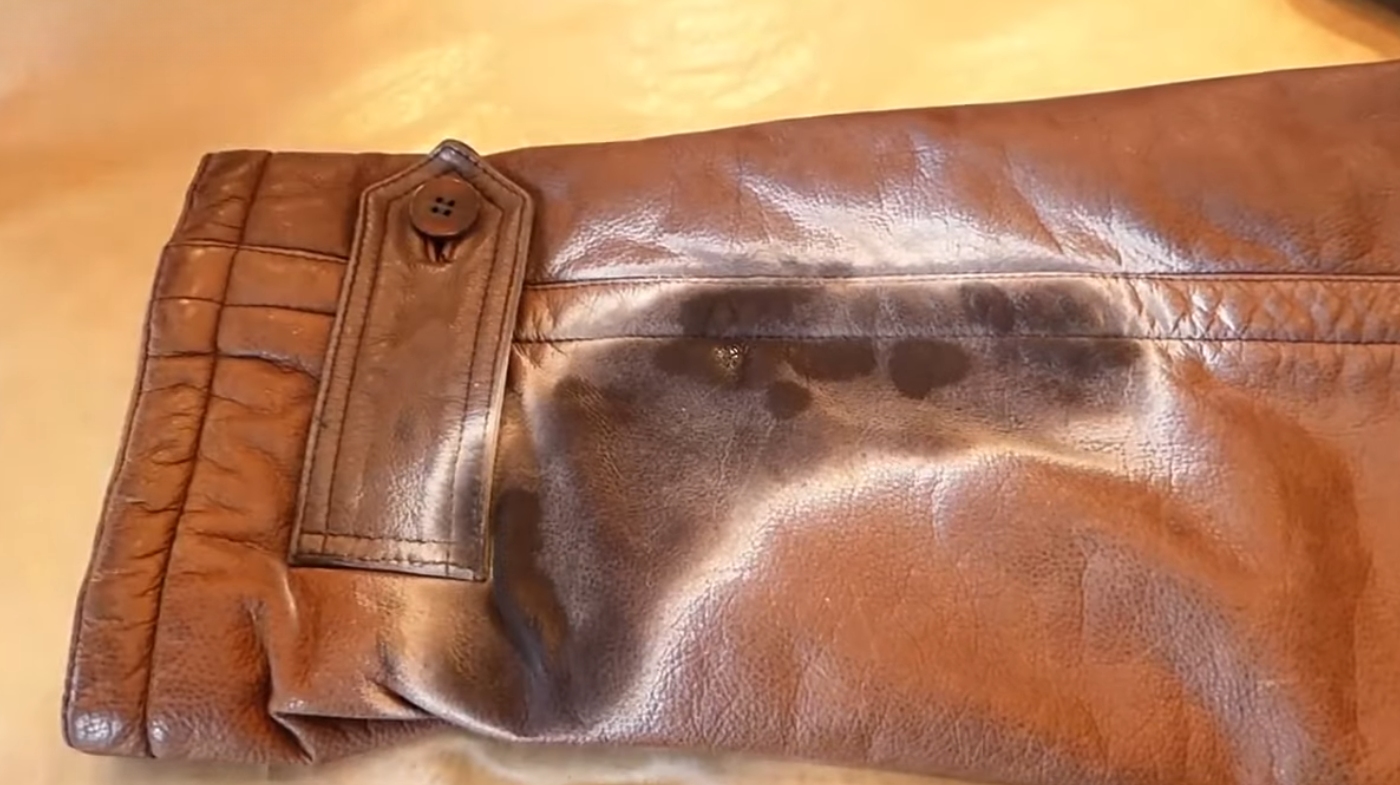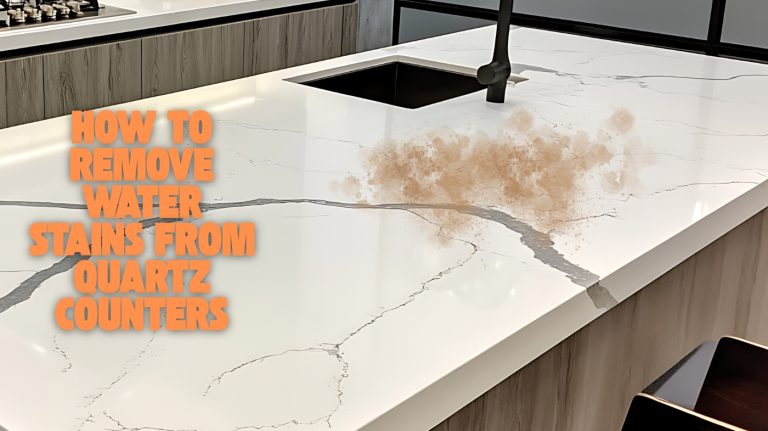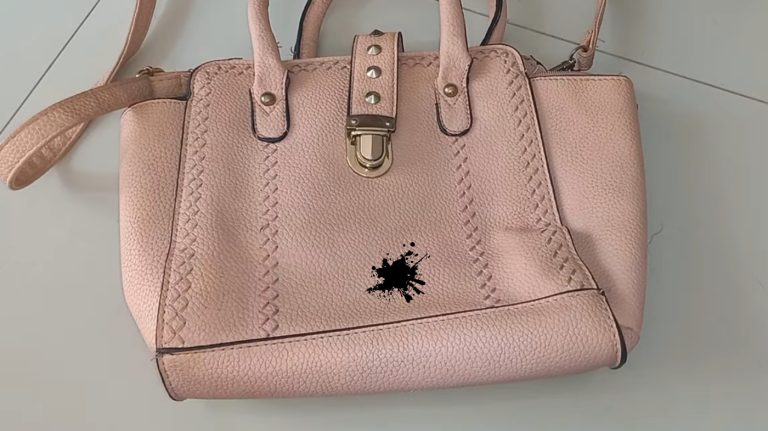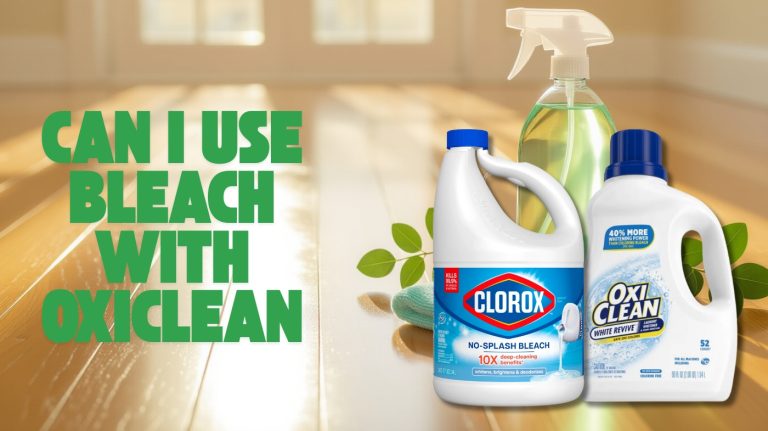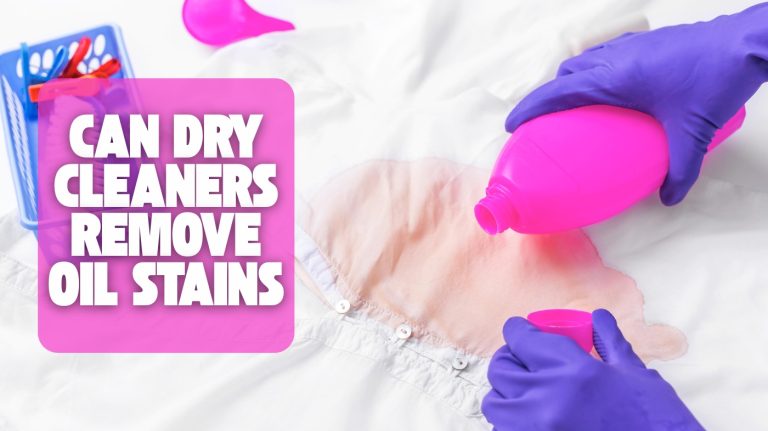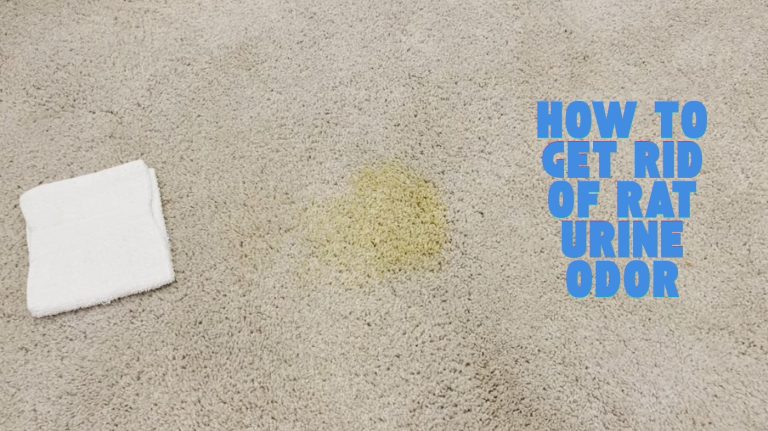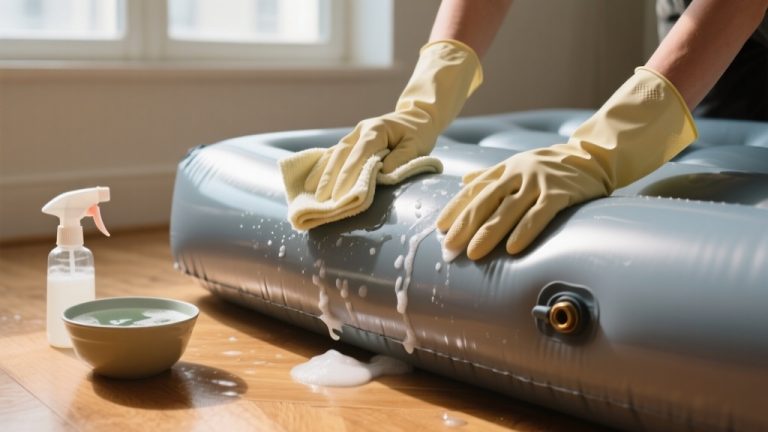How to Get Rid of Water Stains on Leather? Easy Steps
To get rid of water stains on leather, promptly blot the area with a soft cloth to absorb moisture without rubbing.
You can gently clean the stain using a mild soap and lukewarm water mixture or a vinegar-water solution, applied carefully in circular motions.
After cleaning, let the leather air dry and then condition it with a suitable leather conditioner to restore moisture and flexibility.
Following these steps prevents damage and keeps your leather looking great—there’s more to protect and maintain your leather effectively.
Key Takeaways
- Gently blot water stains with a soft, clean microfiber cloth without rubbing to absorb moisture and prevent further damage.
- Clean stains using a mild solution of lukewarm water and dish soap or a 1:1 vinegar-water mix, testing on a hidden area first.
- Wipe off cleaning residues with a damp cloth, then air dry the leather away from heat or direct sunlight.
- Apply a compatible leather conditioner after drying to restore moisture and flexibility, buffing off any excess product.
- Use leather waterproofing treatments regularly and store items in dry, ventilated areas to prevent future water stains.
Immediate Steps to Take When Water Stains Appear
When water stains appear on your leather, the first thing you should do is gently blot the affected area with a soft, clean cloth to absorb excess moisture without rubbing, which can push water deeper into the leather pores.
Use materials like microfiber towels or paper napkins for effective absorption, pressing lightly if the leather feels overly wet.
Avoid aggressive wiping to prevent scratches or new stains, and ensure the area is in a space with good air circulation to help the moisture evaporate faster.
Next, identify your leather type and condition—delicate leathers like suede need extra care and shouldn’t be soaked. Understanding the porous nature of leather helps explain why quick absorption is crucial to prevent lasting damage.
After blotting, you may use a damp microfiber cloth with distilled water to gently wipe in circular motions from the stain’s center outward, ensuring the cloth is clean to avoid dirt transfer.
Finally, let the leather air dry naturally in a ventilated space, away from direct heat or sunlight. Proper ventilation prevents moisture accumulation, which can lead to mold growth or damage to the leather’s surface.
Effective Cleaning Solutions for Water Stains
You can start by mixing lukewarm water with a mild dish soap to gently clean water stains without stripping leather’s natural oils.
For tougher marks, a 1:1 solution of white vinegar and water works well, but apply it sparingly and test first to avoid discoloration.
Both methods require careful application and natural air drying to protect the leather’s integrity. Always dry leather thoroughly after cleaning to prevent further damage dry leather thoroughly.
Vacuuming frequently with a high-efficiency filter vacuum can help maintain leather surfaces and prevent buildup of dirt and oils.
Mild Soap Mixtures
Although water stains can be stubborn, mild soap mixtures offer an effective and gentle solution that preserves your leather’s natural oils and finish.
Mix lukewarm water with a small amount of mild dish soap to create a diluted, frothy solution—never use hot water, which can dry out leather. Using a pH-neutral cleaner is essential to avoid damaging delicate surfaces like leather.
Dampen a clean cloth with the mixture, then gently rub the stained area in circular motions to lift minerals without stripping oils. Avoid vigorous scrubbing to prevent damage. This step helps to redistribute concentrated salts within the leather, improving the stain’s appearance.
Afterward, wipe off soap residue with a damp cloth and let the leather air dry away from heat or sunlight. Finish by applying a leather conditioner to restore moisture and flexibility.
This method is safe for most leather types and balances stain removal with preserving suppleness and appearance.
Vinegar Water Solution
Mild soap mixtures work well for most water stains, but for tougher or older marks, a vinegar water solution offers a more potent alternative.
Mix one part white vinegar with two parts water for gentle cleaning, or use equal parts for stubborn stains. Using solutions that break down mineral deposits can help improve the effectiveness of cleaning.
Always test the solution on a hidden patch first to prevent discoloration. Dab the stain gently with a soft cloth—avoid rubbing, which can harm the leather. Let the leather air dry away from heat or sunlight. It is important to allow the leather to air dry naturally to maintain its shape and prevent damage.
Since vinegar can dry out leather, apply a quality conditioner like Andar once the leather is dry to restore oils and suppleness. Repeat cautiously if needed, but avoid overuse to prevent fading or brittleness.
Proper Techniques for Cleaning Leather Stains
When tackling leather stains, employing gentle cleaning methods is essential to preserve the material’s integrity. Harsh scrubbing or saturating the leather can cause irreversible damage. Instead, follow these expert steps:
Gentle cleaning is key to preserving leather’s integrity while effectively removing stains without causing damage.
- Use a soft, lint-free cloth dampened with a mild soap solution or a leather-specific cleaner. Dab the stain gently without rubbing to avoid embedding it further. Always spot test chemicals on a hidden area first to prevent unintended damage.
- Employ circular motions with the damp cloth to evenly moisten and lift the stain, ensuring you don’t saturate the leather. Immediately blot excess moisture with a dry cloth to prevent damage.
- For sticky residues, scrape gently with a blunt tool before applying the cleaning solution. For delicate leathers like suede, opt for a soft brush instead of a cloth.
Conditioning Leather After Removing Water Marks
After carefully removing water stains using gentle cleaning methods, you’ll want to focus on conditioning your leather to restore its natural balance.
Conditioning replenishes oils lost during cleaning, preventing dryness, cracking, and faded discoloration. It also darkens leather and fades water stains using natural oils like neatsfoot, mink, or beeswax.
Choose a conditioner compatible with your leather type—natural oils like neatsfoot, mink, or plant-based options like beeswax work well.
Apply conditioner evenly with a soft cloth in circular motions, allowing about 30 minutes for absorption before buffing off excess. Using products that are safe for delicate materials ensures the leather remains supple without damage.
Avoid over-saturating to prevent stickiness or dirt attraction. For light-colored leather, use conditioners sparingly to avoid darkening.
You can also try natural remedies like coconut oil or mayonnaise on a small area first, but professional products usually give better, consistent results. Remember to condition only fully dry leather and store it away from direct sunlight afterward.
Tips to Prevent Future Water Stains on Leather
Although leather is naturally durable, preventing future water stains requires proactive care and specific strategies. You can safeguard your leather items effectively by adopting these expert tips:
1. Apply Leather-Specific Waterproofing
Use waterproof sprays or creams designed for leather to create a hydrophobic barrier. Apply outdoors or in a ventilated area and reapply periodically based on exposure.
Waterproofing not only prevents water stains but also stops dirt particles from settling, which helps maintain the leather’s sharp appearance.
Choosing products that are biodegradable and non-toxic can further protect your leather while being environmentally friendly.
2. Practice Prompt Cleaning
Immediately blot spills with a clean, dry microfiber cloth to prevent absorption. Avoid rubbing or using harsh materials that might damage the surface.
3. Store Properly
Keep leather in cool, dry places, away from direct sunlight and humidity. Use breathable storage covers, avoid damp surfaces, and rotate usage to minimize moisture exposure.
When to Seek Professional Leather Care Services?
How do you know if your leather needs professional care rather than a DIY fix? If water stains persist despite home cleaning, or if you notice discoloration, texture changes, or stiffness, it’s time to call in experts.
Delicate leathers like aniline, suede, and nubuck especially require professional treatment to avoid worsening damage. High-value or sentimental items also deserve expert attention. Prompt professional care can prevent lasting damage and restore the leather’s original quality.
Attempting improper cleaning methods may result in hazardous fumes or damage to the leather surface.
| Indicator | Leather Type | Reason for Professional Care |
|---|---|---|
| Persistent stains | Aniline, Nubuck | Specialized stain removers needed |
| Texture changes | Full-grain, Suede | Prevent cracking and peeling |
| Discoloration | All types | Expert recoloring and dye application |
| Mold/mildew presence | Furniture, Bags | Requires professional disinfecting and cleaning |
Frequently Asked Questions
Can Water Stains on Leather Cause Mold or Mildew Growth?
Yes, water stains on leather can definitely cause mold or mildew growth. When you leave moisture trapped in the leather’s porous fibers, it creates an ideal environment for mold spores to develop.
If you don’t dry the stains thoroughly and quickly, residual dampness will encourage fungal growth. To prevent this, you need to act fast by drying, cleaning, and conditioning your leather to maintain its natural resistance against moisture and mold.
Are There Specific Leather Types More Prone to Water Damage?
Think of leather types like different shields in battle against water. Full grain leather, your strongest armor, resists moisture best but still needs care.
Suede and nubuck, delicate silk scarves, soak up water quickly and stain easily. Top grain leather offers moderate defense, while genuine leather is a fragile cloak, prone to damage.
To protect your leather gear, you’ll want to know its type and treat it accordingly to avoid lasting harm.
Is It Safe to Use Household Vinegar on All Leather Products?
You shouldn’t use household vinegar on all leather products. Its acidity can break down fibers, especially on vegetable-tanned or vintage leather, causing damage and dryness.
If you decide to try diluted vinegar, always test on a hidden spot first and neutralize residues to protect metal hardware.
For delicate or coated leathers, vinegar risks discoloration. Instead, opt for mild soap solutions or professional cleaners to keep your leather safe and supple.
How Long Does It Take for Leather to Fully Dry After Cleaning?
Leather typically takes 24 to 48 hours to fully dry after cleaning, depending on factors like thickness and environment.
You’ll want to blot excess moisture immediately and air-dry your leather in a well-ventilated area, avoiding direct heat or sunlight. Thicker leather and high humidity can extend drying time.
Once dry, check for uniform color and suppleness before use, and always apply conditioner to keep your leather soft and protected.
Can Water Stains Permanently Alter the Color of Leather?
Yes, water stains can permanently alter your leather’s color, especially if the leather is natural finish like aniline or crust. The longer water soaks in, the higher the risk of permanent discoloration or blotchy patches. Saltwater and chlorinated water worsen this effect.
To minimize damage, you should dry and condition your leather promptly after exposure. Untreated stains may cause dark spots, stiffness, and cracking, diminishing your leather’s original hue and value.
Show Your Leather Love: Keep It Sleek, Stain-Free and Strong
To tackle those troublesome water stains on your treasured leather, take timely, targeted steps. Clean carefully with chosen solutions, condition consistently to keep leather lush, and protect proactively to prevent pesky problems.
Practicing proper procedures preserves your prized pieces, prolonging their pristine perfection. If stains stubbornly stick, seek skilled specialists to safeguard your investment. Stay smart, stay swift, and show your leather some loving care to keep it looking sleek and spotless.

